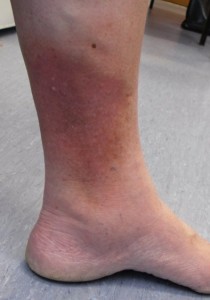CEAP is a classification system for chronic venous disorder and an abbreviation for Clinical, Etiologic, Anatomic and Pathophysiologic. It was created by the American Venous Forum in 1994 with a first revision performed in 2004. The C part of CEAP, the clinical part, should be used in all studies to define the patient population under investigation. It is intended to facilitate comparisons between studies and improve the overall quality of research on venous disease. The classification is as follows:
C0 = No visible or palpable signs of venous disease
C1 = Telangiectasia or reticular veins
C2 = Varicose veins
C3 = Oedema
C4a = Pigmentation and/or eczema
C4b = Lipodermatosclerosis and/or atrophie blanche
C5 = Healed venous ulcer
C6 = Active venous ulcer
Although clinical CEAP is used to classify patients into groups of clinical severity it is not constructed as a severity scoring system for outcomes evaluation even if it has been used as such in some publications. It is not a progressive classification. More research is required into defining each stage of the classification to diminish inter and intra observer variation.
BO EKLӦF The need for an accurate classification system in CVD is fundamental to understanding of the clinical disease processes and to inter-institutional communication about the separate entities. The imprecise diagnoses that were the norm in venous disease throughout the ages have been replaced by accurate non-invasive imaging studies. Once presented with the ability to make accurate diagnoses of the cause and mechanism of chronic disease in the individual segments of the lower extremity veins, it was necessary to devise a classification system capable of organizing the data in a meaningful way. The CEAP classification reduces CVD into its component parts of clinical manifestations, etiologic basis for the disease, anatomic distribution of the disease, and pathophysiologic mechanism operating in the involved venous segments affected by disease. The clinical category of the classification (above) is amended by a notation to indicate whether the diagnosed abnormalities were accompanied by symptoms (s) or were asymptomatic (a).
s = symptoms including ache, pain, tightness, skin irritation, heaviness, muscle cramps, as well as other complaints attributable to venous dysfunction
a = asymptomatic
Based on the CEAP classification the American Venous Forum created the Venous Clinical Severity Score (VCSS) for outcomes assessment. In the upcoming revision of C we should include corona phlebectatica, with a better classification of the severity of symptoms including venous claudication. When I meet a patient with venous disease I think CEAP: what is the clinical picture (C), what is the etiology (E), which segments are involved (A), is it due to obstruction or reflux (P).
